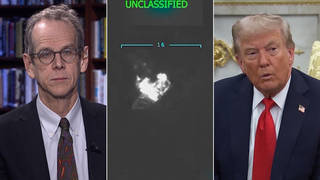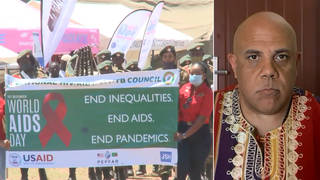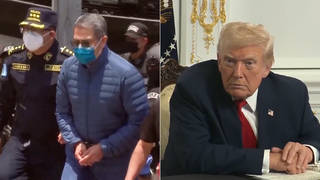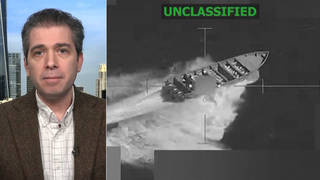
Guests
- Lila Nordstromauthor of the new book Some Kids Left Behind: A Survivor’s Fight for Health Care in the Wake of 9/11 and the executive director of StuyHealth.
- Lisa Katzmandirector and producer of the documentary 9/11’s Unsettled Dust.
As we look at the public health crisis that followed the September 11, 2001, attacks in New York City, we speak with Lila Nordstrom, a student in 2001 at Stuyvesant High School, which neighbors ground zero and was reopened while the site was still burning and releasing toxic smoke and dust. “Our school wasn’t just next to the World Trade Center site, but we were also in the center of the clean-up operations,” says Nordstrom. “There were not any safety precautions being taken to protect us as we walked to and from school. The building that we were attending school in smelled like smoke 24 hours a day for the entire length of time.” Nordstrom is one of the voices in the new PBS documentary “9/11’s Unsettled Dust” and author of a new book titled “Some Kids Left Behind: A Survivor’s Fight for Health Care in the Wake of 9/11.”
More from this Interview
- Part 1: “9/11’s Unsettled Dust”: Bush’s EPA Hid Health Risks from Toxic Dust at Ground Zero & Thousands Died
- Part 2: Joe Zadroga: My 9/11 Responder Son Died from Exposure to Ground Zero as Officials Denied Connection
- Part 3: “Some Kids Left Behind”: After 9/11, No Safety Measures at Stuyvesant H.S. Led to Sickness & Death
Transcript
AMY GOODMAN: Yes, this week marks the 20th anniversary of the 9/11 attacks, and we’re spending the hour looking at the massive environmental and public health crisis that followed at ground zero in New York and how politicians, from the president to the EPA head, Christine Todd Whitman — the president, of course, Bush — prioritized Wall Street’s interests in the aftermath.
Another person who knows this story so well is joining us now: Lila Nordstrom. She was a student at Stuyvesant High School in 2001, which is right next to the World Trade Center towers that collapsed. In the new documentary 9/11’s Unsettled Dust, she explains how the school quickly reopened despite health concerns. She also tells the story in her new book, just out, Some Kids Left Behind: A Survivor’s Fight for Health Care in the Wake of 9/11. She’s executive director of StuyHealth.
Lila, welcome to Democracy Now! Still with us, Lisa Katzman, the director of the film. For people to understand what happened at your school during — after the attack and how the site was used as you kids tried to go to school.
LILA NORDSTROM: I mean, I think that the thing to understand is that our school wasn’t just next to the World Trade Center site, but we were also in the center of the cleanup operations. So, we got sent back to school at a time that the neighborhood was not yet open to the public. We went through five police checkpoints on our first day of school on October 9th, which is less than a month after the attacks. Our school building hadn’t been adequately cleaned. None of the venting had been cleaned. When they actually did clean the venting the following summer, there were inches thick of World Trade Center dust in our school vents.
But also, the barge that they were bringing all of the debris to from the site, that was taking it to Freshkills, was located right next to our school, thanks to a waiver that was signed by George Pataki, the governor then, that allowed them to essentially place a toxic waste dump next to a public school. And one thing to keep in mind is that this — our school was also next to BMCC, so we were next to a community college. There were thousands of students that were attending school there in that period, and there were not any safety precautions being taken to protect us as we walked to and from school. The building that we were attending school in smelled like smoke, you know, 24 hours a day for the entire length of time. And we were there for nine months of the cleanup operation, starting in early October.
JUAN GONZÁLEZ: And, Lila, what were the parents told? Because I remember reporting on the head of the Parents’ Association at that time. And we’re talking about the best high school in the city of New York. And Marilena Christodoulou was — she was constantly battling with school officials and being told that everything was safe, and yet test results inside of Stuyvesant High School were showing abnormally high levels of lead and other contaminants.
LILA NORDSTROM: Yeah. And a lot of — you know, this was an ongoing conversation. It began as soon as we got back, because the Parents’ Association found that we had really been misled about what the safety of the conditions in the school would be when we returned. So, we were told that they would be installing these HEPA filters in the school air system and that they had spent a million dollars cleaning the school. And that just seemed like a large sum. They kept throwing out that number as if that was like a meaningful indication of how safe things were. And when we got back, the parents found that, A, you know, the surrounding area was not yet safe for habitation, and so, of course, the school wasn’t safe for habitation, but also a lot of the things that they had said they would do to protect the air inside of the school had not actually been done. And so, the Parents’ Association and the Board of Ed kind of embarked on this contentious journey where they would each hire their own air quality experts to examine the air quality, and they were kind of calling each other’s results into question.
Meanwhile, though, almost immediately upon our return, students started getting nosebleeds and headaches. And, you know, a chronic cough was, I would say, going around, but it wasn’t a contagious chronic cough, it was just from the air. The school nurse’s line was backed up. Even The New York Times reported that no one could get in to see a school nurse at Stuyvesant. And in that very article, as they are telling — you know, as they’re reporting that no one can get in to see a nurse and there’s widespread respiratory issues going on in the school, the Board of Ed is saying, “Yeah, but don’t worry, there’s not going to be any long-term consequences to this.”
AMY GOODMAN: Well, Lila, we only have a few minutes, and I just wanted to make sure — you know, an HBO doc is coming out this week, documentary, about you, about the Stuyvesant High kids. It does not mention this issue of the environmental health. And one of the people featured is a woman named Catherine Choy. You write about this in the New York Daily News. And at the very, very, very end of the doc, it mentions, oh, and she died of cancer — doesn’t say “9/11-related cancer.” But how this has been whited out of the history?
LILA NORDSTROM: Yeah. And, I mean, that was an incredibly frustrating realization, because she — you know, the federal government presumes that any of the cancers that are on their list of covered conditions are 9/11-linked, so it’s not a stretch to say that her cancer was 9/11-related. That’s something the federal government would acknowledge. And so, the fact that that was omitted from a story that was basically used to exploit a narrative about unity after 9/11, that we did not feel or experience, and that we have become victims of a narrative that, you know, sort of excludes the nonunity piece of that story has been incredibly frustrating.
And it’s an ongoing struggle that we face in terms of, you know, not just seeing our stories reflected in media, but also seeing our sort of access to these programs as valid, seeing our story as one that entitles us to the services that first responders have, as well. And so, a lot of the times survivors don’t even think that they qualify. They don’t believe, you know, that they went through anything, and sort of never seen their story reflected anywhere in a way that validates that it was dangerous.
AMY GOODMAN: Lisa Katzman, you have an amazing documentary. Your final words, in the last 20 seconds? We never allow for soundbites. We say we want the whole meal. But this time.
LISA KATZMAN: I think that the takeaway of this film is that this is a — this issue of lack of accountability that our political leaders have, I think that 9/11 is the beginning of a period of history where we see an increase of this. We saw it in the BP disaster. We even see it in the way — the egregious way that masking was handled during the COVID times, where FEMA was completely corrupted through nepotistic interests.
AMY GOODMAN: We’re going to have to leave it there, but I thank you so much —
LISA KATZMAN: OK.
AMY GOODMAN: — for this remarkable documentary. It’s called 9/11’s Unsettled Dust, directed by Lisa Katzman. Lila Nordstrom, your new book, Some Kids Left Behind. Joe Zadroga, father of NYPD detective James Zadroga. And the remarkable — should have won the Pulitzer Prize — Juan González. I’m Amy Goodman. Thanks for joining us.











Media Options